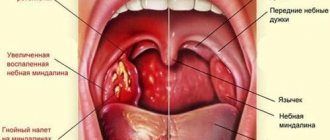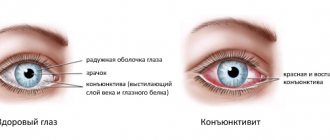Acute tonsillitis is a sore throat that is well known to all of us. The disease is infectious in nature and affects the lymphoid tissue of the palatine tonsils.
The disease occurs at any age, but tonsillitis is more often diagnosed in children.
The palatine tonsils, or the more familiar name “tonsils” to us, are located in the pharynx and are a kind of barrier to infection. Coping with an infection that enters through the mouth, the tonsils remove dead bacteria and viruses from the body and prevent unpleasant diseases from occurring. But if the body’s defenses are not enough, the tonsils cannot cope with the attack, and the pathogenic microflora firmly settles in the tissues of the tonsils, causing inflammation in them.
Why is tonsillitis called acute? Because a sore throat begins suddenly and occurs with severe symptoms.
Most often, acute inflammation of the tonsils is provoked by streptococcus and staphylococcus bacteria, less often the disease is caused by viruses. The following causes of the disease in children are identified:
- past infectious diseases (in this case we are talking about secondary angina);
- the presence of a focus of infection in the child’s oral cavity and nasopharynx (stomatitis, caries, sinusitis, etc.);
- impaired breathing through the nose due to hypertrophied adenoid vegetations or formed polyps;
- anatomical features of the pharynx;
- allergy;
- hypothermia;
- low immunity.
Sore throat is a highly contagious disease. It spreads by airborne droplets or contact. The development of the disease in a child often begins after close communication with other children. After all, the child is constantly in a group, be it a kindergarten, school or section. Therefore, it is not surprising that the diagnosis of “acute tonsillitis” is often present in the anamnesis of young patients.
During a disease epidemic in a child’s preschool or school, if possible, it is better to stay at home.
Sore throat - what is it?
Tonsils are an obstacle to the path of microorganisms into the organs of the lower respiratory system. Microbes accumulate on the surface of the tonsils, multiply and cause a dangerous disease for children - tonsillitis. The disease is often diagnosed in children attending kindergarten or school. Sore throat in a one-year-old child occurs in an acute, severe form and requires mandatory hospitalization. When the first symptoms of the disease appear (lethargy, refusal to eat), you must call a doctor.
Tonsillitis begins with a sudden rise in temperature, severe pain or discomfort, and a tingling sensation in the throat. Nearby lymph nodes enlarge, parents can feel them themselves. Sore throat is a very highly contagious disease and quickly spreads in children's groups by air and droplets, through household items and toys.
Parents note that with a sore throat, the child snores in his sleep. This occurs due to problems breathing through the nose (runny nose) and swelling of the throat. With frequent colds, the adenoids and tonsils remain enlarged and breathing becomes difficult.
Note: If a child’s temperature has risen sharply or symptoms of intoxication have appeared, it is necessary to visit a pediatrician as soon as possible to prescribe a complex of therapy; self-medication and the use of traditional methods are prohibited.
Causes of sore throat in children
One of the common diseases in children during the autumn-winter season is sore throat. If a child does not eat well, or eats not entirely healthy foods, rarely spends time in the fresh air outside the city, is not interested in active physical training, for such a child the cold is a serious stress for the immune system and any hypothermia, frozen feet in the cold, ice cream or a cold drink - provoke the proliferation of pathogenic microorganisms in the oral cavity, more precisely in the lacunae of the tonsils. So, the provoking factors in this case are:
- weakening of the child’s local immunity, that is, the tonsils do not cope with the barrier function - from overwork, irrational, insufficient nutrition
- past viral infections - ARVI, influenza, parainfluenza
- Another option for the development of sore throat may be a focus of inflammation in another organ, for example, if a child has sinusitis or sinusitis, otitis media, caries or adenoids.
- general or local hypothermia, that is, a child staying for a long time at a low temperature or consuming cold drinks and foods
In addition, in close contact with a sick person, a child can become infected through airborne droplets, that is, pathogenic bacteria enter from the outside through coughing and sneezing, through shared utensils or contaminated food (see symptoms of food poisoning in a child).
Improper treatment can lead to chronic tonsillitis, and the causative agent of sore throat, streptococcus, in turn provokes the occurrence of more than 100 other dangerous diseases such as allergies, rheumatoid arthritis, kidney, vascular, and heart diseases. As soon as a child develops alarming symptoms, you should immediately consult a doctor and do not rely only on folk remedies for treating red throat.
Diagnostics
Tonsillitis is classified into several types, each of which has its own clinical manifestations. During a visual examination, the doctor will make a preliminary diagnosis, which is confirmed by laboratory testing of mucus from the tonsils. The smear reveals the causative agents of the disease. Based on the results of the analysis, the pediatrician prescribes a complex of therapy.
If you have a sore throat, your pediatrician will definitely prescribe a blood test. In chronic tonsillitis, an increase in platelets is noted. The indicator returns to normal after treatment for tonsillitis is completed. Changes in ESR (erythrocyte sedimentation rate) and leukocytes will confirm the diagnosis of angina. Laboratory examination of blood parameters is done in order to make a correct diagnosis of the type of disease.
Symptoms of childhood sore throat
Children are more susceptible to infectious diseases, including tonsillitis. The symptoms are more pronounced, the baby is capricious and does not play. The disease often degenerates into a chronic stage and causes complications.
Symptoms of tonsillitis:
- painful or unpleasant sensations in the throat (main symptom);
- tonsils and pharynx become red and swollen (often diagnosed);
- the temperature goes beyond the normal range, often above 38 degrees (there are cases when the disease occurs at a normal level);
- nasal congestion or runny nose (observed during a viral course of the disease);
- weakness (constantly present, especially at a younger age);
- cough (rare);
- headache (diagnosed in some types);
- enlargement of regional lymph nodes (often visible to the naked eye or felt by palpation);
- vomiting, nausea (rarely occurs in severe cases of follicular tonsillitis).
A dry cough develops when the cough receptors in the nasopharynx are irritated. A constant sore throat can also trigger this type of cough.
A damp (wet) cough is diagnosed when the infection moves lower down the respiratory tract, the trachea, bronchi, and lungs become inflamed.
Causes
Tonsillitis occurs under the following circumstances:
- after close and prolonged contact with a carrier of the infection;
- if there was hypothermia;
- with low immunity (after long-term use of antibiotics, in the off-season);
- after moving to another climate zone;
- with long-term inflammatory disease of other organs (sinusitis or otitis media);
- lack of vitamins;
- with abnormal development of opportunistic microorganisms in the oral cavity.
The tonsils act as a barrier and therefore are affected by bacterial pathogens more often than other respiratory organs. Less commonly, tonsillitis is viral. The body is affected by adenovirus, enterovirus, herpes virus or Epstein-Bar virus. With the massive growth of opportunistic microorganisms, a fungal type of tonsillitis occurs.
How to determine a sore throat in a child?
Inflammation of the tonsils develops rapidly: with fever, children do not want to eat, are lethargic and play little. The main complaint is tingling or soreness in the throat. Plaque is visible on the tonsils with the naked eye, they become enlarged, and redness is observed.
Note : The manifestations of sore throat are similar to other diseases, so self-diagnosis should not be carried out so as not to cause harm through improper treatment.
Why do children get sore throat?
Tonsillitis (from the word tonsilla - tonsil) or tonsillitis is an infectious and inflammatory disease of the tonsils. As a rule, a respiratory infection begins to act when it senses a weakening of the body's defenses.
Reduced immunity may be the result of a child's contact with other children. At an early age, they do not yet understand that they should not chew on a dirty toy, or that they should not drink from the same glass as a friend who is already sick. Such instructions are given by parents and they also force them to follow them.
While in a kindergarten or on a playground, where the child leaves the zone of total control, an exchange of infections occurs between children in contact.
Mild flu or just nasal congestion may not alert parents. The hope that the pathological condition will go away on its own and the popular opinion of some that the body needs to be allowed to fight the infectious agent on its own become the cause of complications such as sore throat.
In some cases, it is possible that a viral infection begins to act actively after severe hypothermia, or during a period of chronic fatigue.
Such situations contribute to a sharp decrease in the level of immunity, and an inflammatory process appears in the tonsil area.
The question arises, where, in this case, does the infectious agent come from? It can remain in the body for a long time, suppressed by protective forces. If favorable conditions exist, the virus enters the active stage and the child develops corresponding symptoms.
Types of sore throat
Tonsillitis is classified according to the clinical picture and the nature of the changes in the tonsils. Each type requires its own set of therapy, which is prescribed by the attending physician.
Follicular.
Note: Traditional methods and self-medication are unacceptable.
Pathogenic microorganisms multiply in the follicles of the tonsils, and an inflammatory process develops. When examining the pharynx, red and purulent dots are visible on the tonsils. These are the first manifestations of purulent tonsillitis in children .
Catarrhal Glands with this type become very swollen and red. May act as the initial follicular form.
Lacunar When examining the pharynx, a yellow purulent coating is visible on the enlarged tonsils.
Fibrinous
Regenerates from other species; independent generation is rarely diagnosed. Characterized by a large amount of pus that extends beyond the tonsils.
Phlegmonous
A lesion with purulent discharge forms, and a high fever of over 40 degrees is diagnosed. Requires mandatory medical intervention.
Necrotic (gangrenous)
It is less common than other species. Necrotic ulcers and yellow pus form on the tonsils.
Herpes
Develops when infected with the Coxsackie virus. Red, watery blisters quickly spread throughout the oral mucosa.
How to bring down a child's temperature with a sore throat?
Infectious diseases and colds in children are accompanied by an increase in temperature. At different ages, it is recommended to use different forms of medications. Pharmacies offer a wide selection of antipyretic drugs. Suppositories are recommended for children under one year of age or if it is not possible to take the medicine orally.
If a child’s high temperature with a sore throat does not go away, be sure to call a doctor at home.
Do not rub your child with alcohol-containing solutions. Such products can penetrate the body through the skin and cause harm. You should not further raise the air temperature in the room, creating a greenhouse effect.
Note: It is strictly forbidden to give aspirin-based medications to children.
Nurofen
The active ingredient is ibuprofen. For children, preference is given to the following dosage forms: syrup, suppositories, tablets. It is convenient to give the syrup using a measuring syringe upon reaching three months of age in case of fever and pain. The dosage regimen is followed according to the table on the package, taking into account weight and age.
Nurofen suppositories are convenient for use in infants from three months of age to two years of age.
Note : Parents should not increase or decrease the dosage on their own to avoid negative consequences.
Tablets are recommended for children from six years of age.
Panadol
The drug is similar to Nurofen, but with a different active substance (paracetamol). Syrup and suppositories are used in infants. Instructions for use are indicated in detail on the packaging according to the child’s age and weight. However, do not exceed the dosage recommended by the manufacturer.
Tsefekon
Rectal suppositories for children based on paracetamol. Several dosages are available depending on the age of the patient. 50 mg for children from one to three months. 100 mg – from three months to three years. 250 mg – from three to twelve years.
Viburkol
Homeopathic antipyretic drug for children from the first day of life. Safer in comparison with drugs based on paracetamol and ibuprofen.
Ibuklin Junior
A combination drug with the main active ingredients paracetamol and ibuprofen. The convenient form of soluble tablets is made especially for children.
Traditional medicine tips
If a child (3 years old) has a sore throat, how to treat it with products given to us by nature? According to health experts, folk remedies only help to alleviate the condition of a sick baby. They relieve painful symptoms in the throat and help the child’s body cope with the disease faster. However, they cannot replace antibiotics.
If a child (3 years old) has a sore throat, how to treat a small patient with folk remedies? There are many recipes for this.
The first tip is to insulate your throat. It should be tied with a mohair or wool scarf. This simple procedure will improve blood circulation and enhance lymph flow. In addition, the child should be given plenty of warm fluids. In this case, tea with lemon, fruit jelly, fruit drinks, rosehip or viburnum decoction, mineral water, etc. are suitable. Drinking a large amount of liquid will help the body quickly get rid of toxic products that accumulate in the body during illness.
Already at the first stage of the illness, the baby must be put to bed. This regime will need to be observed not only during the period of temperature rise, but also two to three days after it normalizes. This is necessary in order to avoid disturbances in the functioning of the cardiovascular system, which are not uncommon with angina. That is why it is advisable to spend the dangerous period in bed.
If a child (3 years old) has a sore throat, it can be treated with inhalations. For this, improvised means that are found in every home are suitable. Onion inhalations are very effective. The healing vegetable is grated and placed in a glass. Next, take a towel and twist it into a funnel. You should breathe onions through this homemade tube. The session usually lasts about three to five minutes and repeats every three hours. It is worth keeping in mind that the onion must be freshly grated. Otherwise, the effectiveness of the product is significantly reduced.
Similar inhalations can be performed with garlic and onions. Breathe effectively over freshly boiled potatoes.
Traditional healers recommend warming your throat with buckwheat. To do this, the cereal should be poured into a frying pan and heated over fire. After this, the hot buckwheat is placed in a bag and the throat is warmed with it. This method is especially good in the initial stages of the disease. However, it should be borne in mind that warming up is prohibited when body temperature rises.
Don't forget about raspberry jam and honey. These products will not only help a sore throat, but will also be fun for your baby. Spread jam or honey on a deep plate and invite your child to lick it. Usually children agree to do this with pleasure. In the process of licking the product, the root of the tongue will tense and blood circulation in the throat will improve. At the same time, the neck is disinfected.
Traditional doctors advise treating sore throat with lemon. Two or three slices of this fruit should be peeled and the white film removed from them. Alternately, pieces of lemon will need to be placed in the child’s mouth, closer to the throat. The ideal option is one in which the baby absorbs the lobules. But even if the child cannot do this, the healing fruit will have its disinfecting effect. The procedures are repeated every three hours. In the initial stages of the disease, this method can even somewhat stop the spread of infection.
If there is plaque on the tonsils, you will need to rinse. To do this, prepare a solution of 1 tsp. alcohol tincture of St. John's wort, calendula or eucalyptus and one hundred grams of warm water. The child’s neck should be washed with this medicine five to six times a day. For rinsing, you can take a head of garlic, crushed into a pulp and poured with a glass of warm boiled water. During the procedure, the solution should not get through the throat into the ears. To avoid this, you will need to play chicken with your baby, tilting his head back and asking him to continuously repeat “ko-ko-ko.”
At the end of the rinsing procedure, it is advisable to give the child a drug with an antiseptic in the form of a lollipop. For angina, medications whose main components are phenol, chlorhexidine or dequalinium chloride have a good effect. Medicinal lollipops can also be made independently. The recipe for this drug includes the following ingredients: - 2 tbsp. l. carrots, grated on a fine grater; - 1 tbsp. l. honey; - 20 drops of propolis tincture (sold in pharmacies); - 1 tsp. lemon juice; - 1 tsp. sea buckthorn or rosehip oils.
All components should be mixed, then put half a teaspoon of the drug under the child’s tongue. The baby should dissolve this lollipop slowly.
A warm compress will ease the child's condition. To prepare it you will need to take two parts of honey, one part of aloe and 3 parts of vodka. Several layers of bandage are impregnated with this mixture, which should be placed on the baby’s neck, closer to the jaw. This is all covered with film and wrapped in a warm scarf. This compress is changed three times during the day. In addition, it must be made new overnight.
At the acute stage of the disease, a compress of cottage cheese will help the baby. It will relieve even the most acute pain. To carry out this procedure, wrap one hundred grams of squeezed cottage cheese at room temperature in a linen cloth. The product prepared in this way is applied under the baby’s jaw. The top of the fabric with cottage cheese is covered with film, and the neck is wrapped with a scarf.
Traditional methods of treatment
Traditional methods of treatment are effective when used together with drug therapy.
Kill viruses and bacteria and disinfect the air in the room with chopped onions. It is placed in a plate in the child's room. Onions contain phytoncides that help fight viruses and bacteria. Due to the high content of vitamins, minerals and biologically active substances, onions are used as the main remedy against influenza and sore throat.
Another folk remedy for gargling is beetroot juice. It must be diluted in a glass of water and rinsed three times a day.
Apple cider vinegar is a popular home remedy. Its solution with boiled water helps to wash away mucus and purulent plugs from the surface of the throat and tonsils.
Another natural antiseptic from the garden is arugula. If this greenery grows in the garden, you can squeeze the juice out of it and gargle. Active biological substances kill infections in the respiratory tract.
Sea buckthorn oil has bactericidal properties. It is used to lubricate the throat and as a gargle. You can prepare a healthy drink with sea buckthorn oil and honey. Drink in small sips three times a day.
An effective folk remedy is a solution of lemon or citric acid with boiled water.
Contraindications to this method:
- for allergic reactions;
- as the only method of therapy;
- infants up to three months (after this age, the list of remedies is strictly limited).
At home, prepare fruit drinks, infusions and decoctions for your child using:
- chamomile;
- linden;
- sage;
- lemon;
- cranberries;
- black currant;
- raspberries;
- calendula.
Inhalations
Inhalations for sore throat help relieve symptoms, relieve inflammation, and moisturize the mucous membrane of the respiratory tract. At home, inhalation with a nebulizer with drugs and steam methods are used.
Contraindications for sessions:
- bleeding;
- high temperature (above 38 degrees);
- Children under one year of age are prohibited from using a nebulizer; children under seven years of age are prohibited from using steam inhalers;
- vascular diseases.
Antibiotic solutions (ciprofloxacin) and mineral water (Borjomi, Essentuki) are added to the nebulizer for the treatment of sore throat. The vapors of the product penetrate deeply into the mucous membrane of the respiratory tract and act directly on the pathogen. Mineral water softens and moisturizes.
Steam inhalations are made with essential oils, decoctions and infusions of medicinal herbs.
For warm procedures use:
- chamomile;
- sage;
- oak bark;
- eucalyptus leaves;
- calendula;
- sea buckthorn oil;
- eucalyptus oil;
- fir ether;
- rosemary oil
The duration of a steam inhalation session is 15-20 minutes.
Note: It is important to control the water temperature so that hot vapors do not burn the mucous membrane of the respiratory tract.
Decoctions
Compresses with vodka or alcohol are contraindicated for sore throat. It is allowed to apply cabbage leaves to the throat for 10-15 minutes three times a day and wrap it with a warm scarf.
Milk with honey helps boost immunity, soothe the throat and improve well-being.
Decoctions and infusions of herbs are used in the form of inhalations and drunk as tea.
Fruit drinks, compotes with cranberries, lemon and lingonberries increase immunity and kill germs.
Honey mixed with lemon juice quickly relieves sore throat. Keep a teaspoon of the product in your mouth until completely dissolved.
If the child is not allergic to bee products, a piece of propolis will be an effective pain reliever and anti-inflammatory agent. It is held in the mouth or chewed until dissolved.
An ancient good method of fighting infection is a decoction of marshmallow root. Gargle with infusion three times a day.
Cloves are often used in folk medicine for their antibacterial properties. For sore throat, make an infusion and gargle three times a day.
Foot baths for sore throat are allowed from the age of five, when the acute period of the illness has passed and the temperature has dropped to normal levels. Add water at a temperature of 38 degrees and three tablespoons of mustard to the container. The session lasts 15 minutes.
Unacceptable actions of parents
Under no circumstances should you:
- Apply warm compresses to the neck area. Cold compresses are also not recommended, but warm ones are especially dangerous. Swelling in the tonsil area from heat exposure can increase and cause the airways to close.
- Force feed your baby. He may experience severe pain when swallowing or may have no appetite. You can try to interest him in the original design of children's dishes or gently persuade him, but you should not force him.
- Lubricate the tonsils with various antibacterial solutions (for example, Lugol's solution). Not so long ago, such actions were actively practiced, but at this time, experts have come to the conclusion that mechanical action damages the mucous membrane and bacteria penetrate tissue more easily.
Complications
If a sore throat is not treated in time, bacteria attack the internal organs. Microorganisms descend further down the respiratory tract and cause inflammation of the bronchi and lungs. Bacteria spreading through the nasopharynx cause otitis media.
A cough with a sore throat in a child may be due to an irritated throat, or it may be a sign of inflammation in the lower respiratory tract.
With prolonged absence of antibiotic therapy, the condition worsens and sepsis appears. Streptococcus is a very insidious bacterium that quickly spreads throughout the tissues of the body and affects the heart, joints, and kidneys. At the end of treatment, it is necessary to show the child to the pediatrician and take a repeat blood test.
Photo: what it looks like
If clearly defined white or yellow dots with purulent contents appear on the surface of the lymphoid tissue, this is a sign of lacunar tonsillitis.
If the pathology is listed as catarrhal, pus does not form on the tonsils. In this case, the child may experience a runny nose during the latent stage. Also, due to mucus flowing into the throat, a productive cough with a large amount of sputum begins.
In what cases is hospitalization indicated?
Vomiting with sore throat occurs as a reaction to taking antibiotics or due to severe intoxication. In such cases, it is necessary to call an ambulance team. The child may need to be hospitalized.
It is imperative to make a decision in favor of hospital treatment in the following cases:
- if the child is less than a year old (the risk of developing complications and pathologies is very high);
- with concomitant diseases (blood clotting dysfunction, renal failure, diabetes);
- if there are symptoms of severe intoxication, confusion;
- with the development of complications in the kidneys, heart and joints;
- if antipyretic drugs do not help.
Disease prevention, sunbathing, vitamins
To avoid frequent colds and infectious diseases, it is necessary to teach your child to lead a healthy lifestyle and observe the rules of hygiene.
Prevention rules:
- Taking multivitamins in the off-season will help strengthen the immune system;
- active lifestyle;
- playing sports;
- hardening;
- sunbathing;
- maintaining hygiene;
- complete and balanced nutrition;
- visiting cities with sea air to strengthen the immune system;
- regular examination by a doctor and timely treatment of sore throat in children;
- daily cleaning, ventilation and use of a humidifier for the home.
For 2021, there are many sprays for the prevention of influenza and colds (Timogen, IRS-19, Grippferon, Derinat).
Prevention
For prevention, it is necessary, if possible, to prevent the child from communicating with patients with tonsillitis.
In addition, to prevent any infectious disease, it is necessary to keep the baby’s immune system in good shape. The child will also benefit from proper and regular nutrition (it is better to eat more often, but in small portions), natural juices, tea and clean water.
Do not allow the small organism to become hypothermic. Walk with your baby in the fresh air, which helps strengthen the immune system. The room where the child is most often located must be ventilated and regularly wet cleaned.
How to treat dry cough in an adult
The causes and treatment of snoring in women are described in this article.
Allergic cough in a child: //drlor.online/diagnostika-lechenie/kashel/lechenie-allergicheskogo-kashlya-u-rebenka.html










